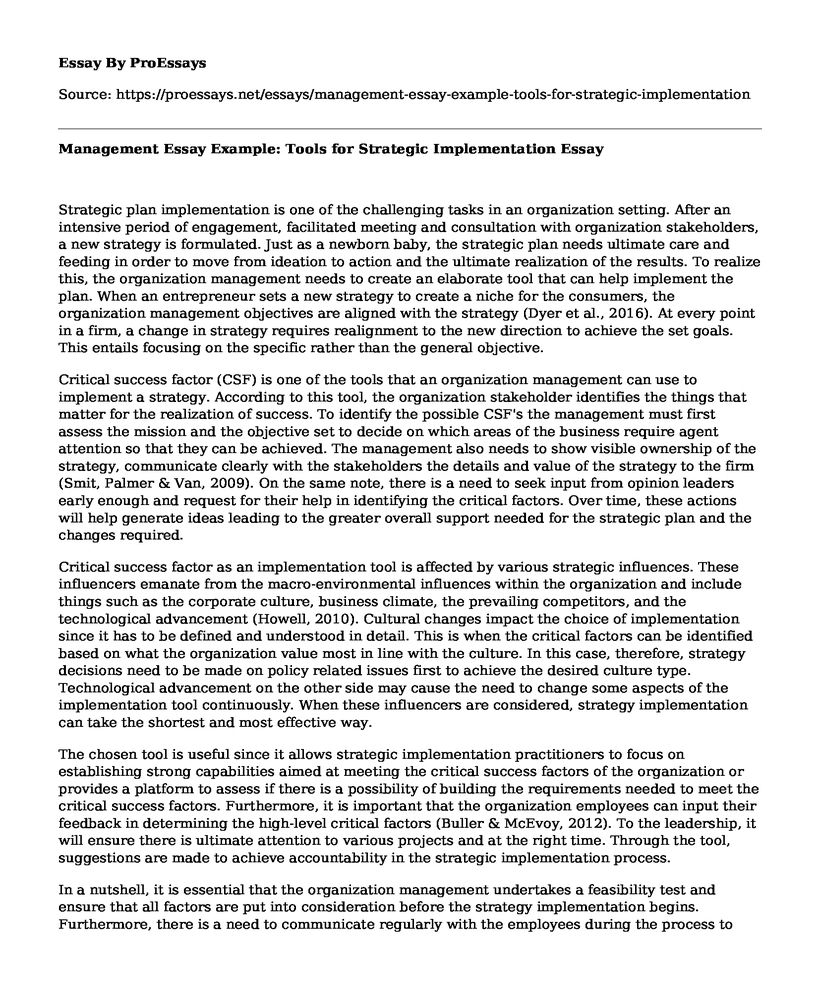Strategic plan implementation is one of the challenging tasks in an organization setting. After an intensive period of engagement, facilitated meeting and consultation with organization stakeholders, a new strategy is formulated. Just as a newborn baby, the strategic plan needs ultimate care and feeding in order to move from ideation to action and the ultimate realization of the results. To realize this, the organization management needs to create an elaborate tool that can help implement the plan. When an entrepreneur sets a new strategy to create a niche for the consumers, the organization management objectives are aligned with the strategy (Dyer et al., 2016). At every point in a firm, a change in strategy requires realignment to the new direction to achieve the set goals. This entails focusing on the specific rather than the general objective.
Critical success factor (CSF) is one of the tools that an organization management can use to implement a strategy. According to this tool, the organization stakeholder identifies the things that matter for the realization of success. To identify the possible CSF's the management must first assess the mission and the objective set to decide on which areas of the business require agent attention so that they can be achieved. The management also needs to show visible ownership of the strategy, communicate clearly with the stakeholders the details and value of the strategy to the firm (Smit, Palmer & Van, 2009). On the same note, there is a need to seek input from opinion leaders early enough and request for their help in identifying the critical factors. Over time, these actions will help generate ideas leading to the greater overall support needed for the strategic plan and the changes required.
Critical success factor as an implementation tool is affected by various strategic influences. These influencers emanate from the macro-environmental influences within the organization and include things such as the corporate culture, business climate, the prevailing competitors, and the technological advancement (Howell, 2010). Cultural changes impact the choice of implementation since it has to be defined and understood in detail. This is when the critical factors can be identified based on what the organization value most in line with the culture. In this case, therefore, strategy decisions need to be made on policy related issues first to achieve the desired culture type. Technological advancement on the other side may cause the need to change some aspects of the implementation tool continuously. When these influencers are considered, strategy implementation can take the shortest and most effective way.
The chosen tool is useful since it allows strategic implementation practitioners to focus on establishing strong capabilities aimed at meeting the critical success factors of the organization or provides a platform to assess if there is a possibility of building the requirements needed to meet the critical success factors. Furthermore, it is important that the organization employees can input their feedback in determining the high-level critical factors (Buller & McEvoy, 2012). To the leadership, it will ensure there is ultimate attention to various projects and at the right time. Through the tool, suggestions are made to achieve accountability in the strategic implementation process.
In a nutshell, it is essential that the organization management undertakes a feasibility test and ensure that all factors are put into consideration before the strategy implementation begins. Furthermore, there is a need to communicate regularly with the employees during the process to ensure a smooth transition.
References
Buller, P. F., & McEvoy, G. M. (2012). Strategy, Human resource management, and performance: Sharpening line of sight. Human Resource Management Review, 22(1), 4356. doi:10.1016/j.hrmr.2011.11.002.
Dyer, J. H., Godfrey, P., Jensen, R., & Bryce, D. (2016). Strategic Management: Concepts and tools for creating real world strategy. Hoboken, NJ: John Wiley & Sons.
Howell, M. (2010). Critical success factors simplified (1st ed.). Boca Raton: CRC Press.
Smit, P. J., Palmer, P. N., & Van, M. M. A. (2009). Strategy implementation: Readings. Kenwyn: Juta.
Cite this page
Management Essay Example: Tools for Strategic Implementation. (2021, Apr 01). Retrieved from https://proessays.net/essays/management-essay-example-tools-for-strategic-implementation
If you are the original author of this essay and no longer wish to have it published on the ProEssays website, please click below to request its removal:
- Industrial Psychology Essay
- Business Consulting Industry Paper Example
- Biogeochemical Processes and Ethics in Organic Store's Operations Essay
- Tool Creation, Visitation, and Analysis of an Organization Paper Example
- Paper Example on The Impact of Computer Workstations on Performance
- Essay Example on Leadership Goals: Self-Discipline, Responsibility, Integrity
- Essay Example on Gender Roles in Religion: Women in Leadership?







